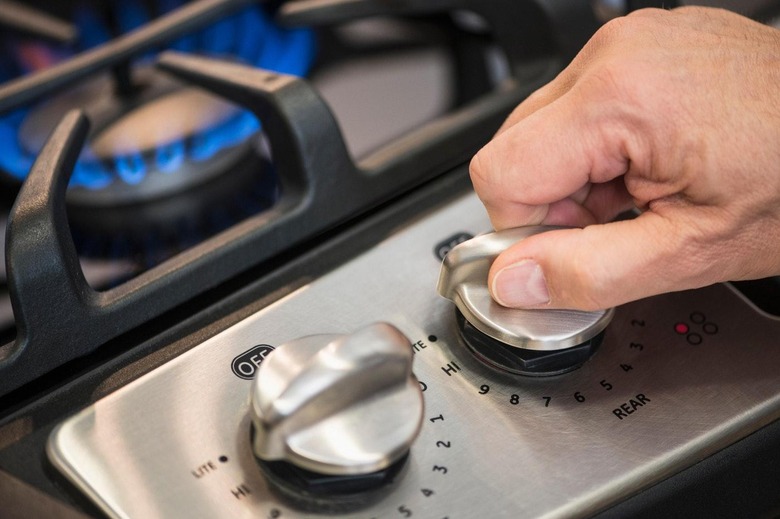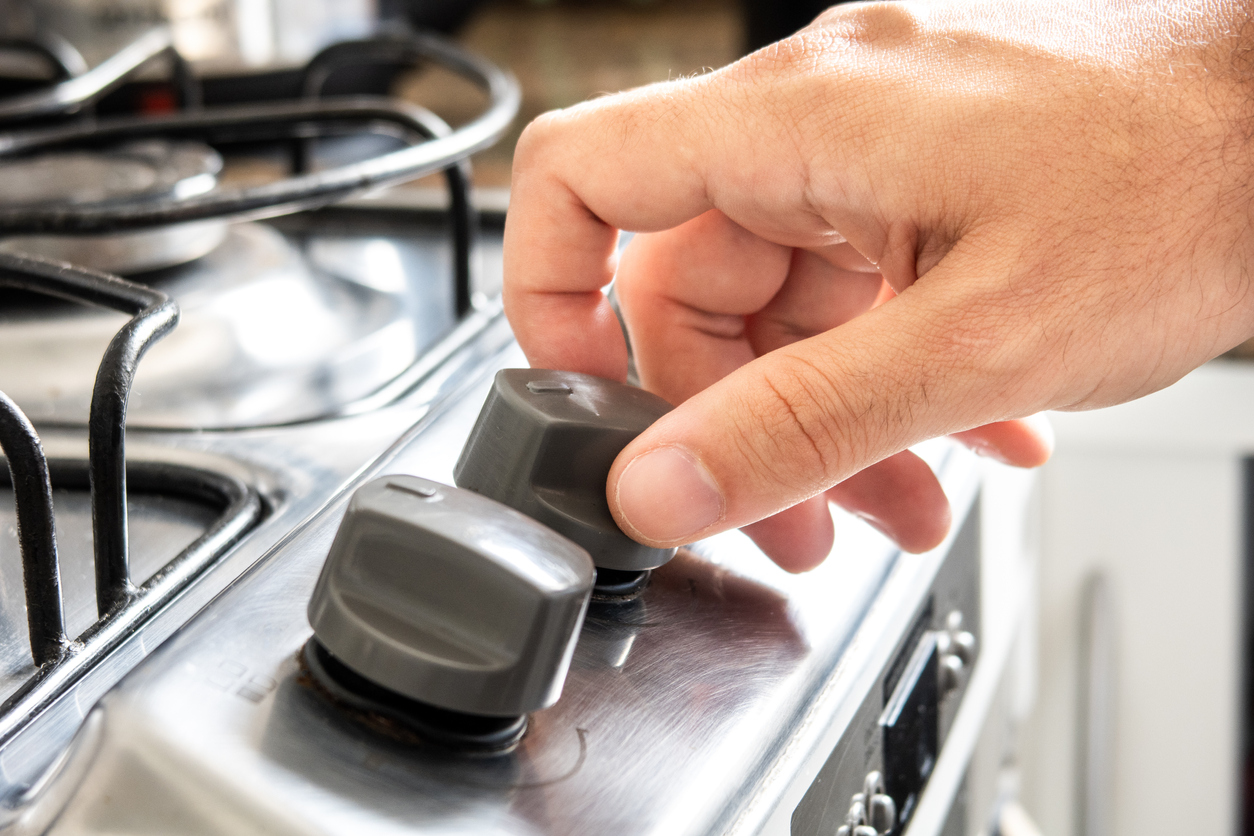How To Turn Gas Off To Stove
:max_bytes(150000):strip_icc()/shutting-off-gas-to-the-stove-2718660-04-309472f8bae64c65bc3fd4a399496458.jpg)
Understanding basic gas safety is a crucial skill for anyone working with or around natural gas appliances. While not directly within the HVAC scope, the ability to safely shut off gas to a stove can prevent emergencies and protect lives and property. This knowledge is valuable for HVAC professionals, especially when working in residential settings where gas stoves are common. For students entering the field, understanding safety protocols demonstrates responsibility and initiative to potential employers.
Locating the Gas Shut-Off Valve
The first step in turning off the gas to a stove is locating the shut-off valve. This valve is typically located behind the stove, either on the wall or on the gas supply pipe itself. In some older homes, the valve may be in the basement or a nearby utility closet. Look for a small, lever-operated valve, often yellow in color. It's crucial to know the location of this valve *before* an emergency arises.
Important Safety Tip: If you smell gas, evacuate the area immediately and call your local gas company or emergency services from a safe location. Do not attempt to locate or shut off the gas valve yourself in this situation.
Step-by-Step Instructions for Shutting Off the Gas
Once you've located the gas shut-off valve and confirmed it's safe to proceed, follow these steps:
- Clear the Area: Ensure there are no flammable materials or open flames near the stove or gas valve.
- Identify the Valve Type: Most gas shut-off valves are quarter-turn ball valves. These valves are either open or closed. A lever that's parallel to the gas pipe indicates the valve is open, while a lever perpendicular to the pipe indicates it's closed.
- Turn the Valve: Using a wrench if necessary, turn the valve lever 90 degrees so that it's perpendicular to the gas pipe. This will shut off the gas supply to the stove.
- Test the Shut-Off (Optional): After turning off the valve, you can briefly try lighting a burner on the stove to confirm that the gas has been shut off. If the burner doesn't light, the valve is properly closed. *Do not* repeatedly attempt to light the burner, as this can release gas into the air.
- Contact a Professional: If you shut off the gas due to a leak or other problem, contact a qualified HVAC technician or gas company representative to inspect the system and make necessary repairs before turning the gas back on.
The Importance of Gas Safety for HVAC Professionals
While HVAC systems primarily focus on heating, ventilation, and air conditioning, many HVAC technicians work with appliances that utilize natural gas or propane. A solid understanding of gas safety protocols is not only essential for your safety but also enhances your credibility and value as a professional. Familiarity with gas line locations and shut-off procedures can be invaluable in emergency situations and during routine maintenance or installations.
According to the U.S. Bureau of Labor Statistics, the median annual wage for HVAC technicians and installers was $51,390 in May 2022. The job outlook is projected to grow 6 percent from 2022 to 2032, about as fast as the average for all occupations. This growth is driven by increasing demand for energy-efficient HVAC systems and the need to replace aging equipment. Proficiency in gas safety can give you a competitive edge in a growing job market, especially for entry-level positions. Starting salaries often range from $35,000 to $45,000, with experienced technicians and supervisors earning upwards of $70,000 or more.
Certifications and Training
Several certifications are relevant to HVAC professionals working with gas appliances:
- NATE (North American Technician Excellence): NATE certification demonstrates competency in specific HVAC areas, including gas heating. While not mandatory in all states, NATE certification is widely recognized and valued by employers.
- EPA 608 Certification: This certification is required for technicians who handle refrigerants. While not directly related to gas safety, it's a standard requirement for most HVAC jobs.
- Gas Piping Certifications: Depending on your location, specific certifications may be required for installing or repairing gas piping. Check with your local licensing board for details.
- OSHA Training: Completing OSHA safety training, specifically related to gas handling and safety procedures, is highly recommended.
Beyond certifications, continuous training is essential to stay updated on the latest safety regulations, technologies, and best practices. Many HVAC schools, trade associations, and manufacturers offer training courses on gas safety and appliance repair.
Career Paths in HVAC: A Real-World Perspective
The HVAC industry offers diverse career paths. Here are a few examples:
- Residential HVAC Technician: Focuses on installing, maintaining, and repairing HVAC systems in homes. This role often involves working with gas furnaces and other gas-powered appliances.
- Commercial HVAC Technician: Works on larger, more complex HVAC systems in commercial buildings. These systems often involve advanced controls and gas-powered equipment.
- HVAC Service Manager: Oversees a team of HVAC technicians, managing schedules, providing technical support, and ensuring customer satisfaction.
- HVAC Sales Engineer: Designs and sells HVAC systems to commercial and industrial clients. This role requires a strong understanding of HVAC principles and gas appliance technology.
- HVAC Instructor: Teaches HVAC principles and practical skills to students in trade schools or apprenticeship programs.
Example: Sarah, a recent graduate of an HVAC program, started her career as a residential HVAC technician. Her knowledge of gas safety protocols impressed her employer, allowing her to quickly take on more complex tasks involving gas furnace repair. Within five years, she earned her NATE certification and was promoted to lead technician, overseeing a team of junior technicians and handling complex troubleshooting jobs.
HVAC Industry Trends and the Future of Gas Appliances
The HVAC industry is constantly evolving, with a growing emphasis on energy efficiency and sustainability. While electric heat pumps are gaining popularity as an alternative to gas furnaces, gas appliances will likely remain a significant part of the heating landscape for the foreseeable future. The rise of high-efficiency gas furnaces and hybrid heating systems (combining gas and electric technologies) suggests a continued demand for skilled technicians who can work with both gas and electric systems.
Furthermore, the development of renewable natural gas (RNG) and hydrogen-blended natural gas offers potential pathways to reduce the carbon footprint of gas appliances. HVAC professionals who stay informed about these emerging technologies will be well-positioned to thrive in the future.
Employer Considerations: Hiring and Training Skilled Workers
For employers in the HVAC industry, hiring skilled workers with a strong foundation in gas safety is paramount. When evaluating candidates, consider the following:
- Certifications: Prioritize candidates with relevant certifications, such as NATE, EPA 608, and gas piping certifications.
- Experience: Look for candidates with hands-on experience working with gas appliances.
- References: Check references to verify the candidate's skills and work ethic.
- Background Checks: Conduct thorough background checks to ensure the candidate has a clean safety record.
- Ongoing Training: Invest in ongoing training for your employees to keep them up-to-date on the latest safety regulations and technologies.
Employers should also establish clear safety protocols and provide employees with the necessary tools and equipment to work safely with gas appliances. Regularly review safety procedures and conduct drills to ensure that employees are prepared for emergencies. Providing access to specialized training such as pipe fitting or advanced diagnostics, significantly increases your team's overall proficiency.
Conclusion
Knowing how to turn off the gas to a stove is a basic safety skill that can prevent accidents and protect lives. For HVAC students and professionals, a strong understanding of gas safety is essential for career success. By investing in certifications, continuous training, and a commitment to safety, you can build a rewarding and fulfilling career in the HVAC industry. For employers, prioritizing safety in hiring and training practices is crucial for protecting your employees and your business. The ability to work safely and competently with gas appliances is a valuable asset in a growing and evolving industry.
Remember to always prioritize safety and consult with qualified professionals for any gas-related issues.
Disclaimer: This article provides general information and should not be considered a substitute for professional advice. Always follow local regulations and consult with qualified professionals for any gas-related issues.
:max_bytes(150000):strip_icc()/shutting-off-gas-to-the-stove-2718660-02-ac8dbb9a52514991a6ad65c6543ceec1.jpg)
/close-up-of-a-gas-stove-burner-126173751-57a37ea13df78cf45927d275.jpg)





:max_bytes(150000):strip_icc()/shutting-off-gas-to-the-stove-2718660-05-f585effcdd3b4056a0db078761648117.jpg)
:max_bytes(150000):strip_icc()/shutting-off-gas-to-the-stove-2718660-hero-033bbdf1503f455e8dcca0f2c668a154.jpg)

